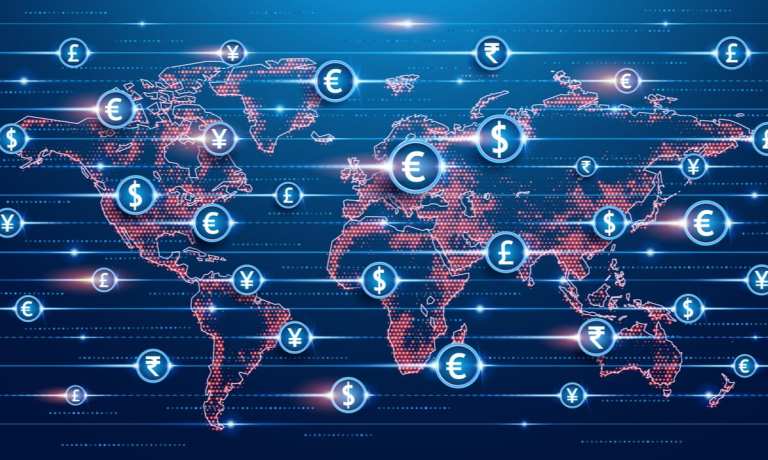Whether it is a multinational making payments to strategic suppliers or a business making payments to gig workers, the globalization of trade, and the massive shift to digital over the last 18 months have amplified the need to streamline the way that money moves between people and businesses across borders.
A recent PYMNTS/Visa study shows that, on average, 26 percent of a company’s revenue now comes from cross-border buyers; the larger the company, the larger the percentage of sales from outside their domestic market.
With those sales also comes the delay in accessing those funds. On average, according to the same study, companies wait as much as a third longer for cross-border payments to post to their accounts.
Against that backdrop, Goldman Sachs and Visa announced a strategic partnership Monday (June 7) that will simplify cross-border payments flows for Goldman’s transaction banking clients. Through this partnership, Goldman’s corporate clients can streamline both high-value, low-frequency cross-border payments flows, such as real estate transactions, and low-value, high-frequency flows, such as small business recurring payments, via a single application programming interface (API) integration, file or online web platform.
High-value flows leverage Visa B2B Connect, an account-to-account (A2A) cross-border payments network now available in 97 markets. Low-value payments will leverage the cross-border capabilities of the recently-launched Visa Direct Payouts, which will push payments to millions of consumer and small- to medium-sized business (SMB) accounts.
Visa’s cross-border money movement efforts map back to its “network of networks” strategy, Alan Koenigsberg, global head of New Payments Flows at Visa Business Solutions, told Karen Webster. Visa aims to be a single connection point for clients to move value over Visa networks, such as Visa Direct and Visa B2B Connect, or new networks in the future, he said.
Advertisement: Scroll to Continue
Through Visa Direct, financial institutions (FIs) and their corporate customers can reach 16 card networks, 65 ACH networks, seven real-time payment schemes and five payment gateways — all through a single connection. In addition, they can reach all relevant real-time gross settlement (RTGS) systems in the 97 markets for Visa B2B Connect.
Koenigsberg said the partnership with Goldman is an important reflection of Goldman Sachs’ own efforts to modernize B2B payments.
According to Koenigsberg, partnership discussions revealed more than just a desire to “fix” cross-border payments but a shared vision for giving corporates better tools and more control over their own payments flows. Reinventing the process meant alignment around the need to redo the basic infrastructure for how money and data flows move securely between parties globally, giving banks like Goldman and their corporates new ways to reimagine their cross-border business opportunities.
Making progress, Koenigsberg said, was a collaboration focused on overcoming some of the most pressing points of friction that have existed for decades in the traditional cross-border processes.
Re-Imagining The Experience
FIs may have a lot to consider about the impacts of cross-border payments overhaul. Increasingly, players like Goldman Sachs are stepping up as key collaborators and innovators with the understanding that the status quo existing processes no longer suit the needs of modern corporations.
When Goldman Sachs first began discussions with Visa, Koenigsberg said the company’s goal was to make all cross-border payments — the high-value, complex supplier payments to any corporate account — as easy as making a domestic low-value payment.
That kicked off a broad-level discussion that did not focus on the nuances of one particular payment rail or use case, but instead targeted a better end-user experience through the combined powers of Visa’s network of networks strategy. The pressing need was to overcome the three things that continue to challenge the industry: where the funds are, when they will arrive and cost.
The Visa-Goldman partnership that emerged represents a real contrast to the ways that FIs have been facilitating cross-border B2B payments, and indeed, embracing a paradigm shift is also likely to have an impact in other areas.
With regard to Visa B2B Connect, Koenigsberg said he has already seen significant expansion since it first landed on the market two years ago. The addition of Goldman Sachs as a client will continue to drive growth, with Koenigsberg noting the collaboration is “more than just simply a product sale and distribution. This is a strategic relationship.”
What’s Next
Visa and Goldman will continue to collaborate with the common goal of reinventing cross-border payments from the ground up, and there is still plenty of work to be done. On the high-value payments side, as Visa B2B Connect adds new currencies, geographic markets and FI partners, Koenigsberg pointed to other key opportunities to make progress, including taking an industry-targeted approach to servicing corporates’ global payment needs. On the Visa Direct Payouts side, the number of use cases from established corporates and internet platforms to pay workers and suppliers will only increase as new direct-to-consumer (D2C) retail models and remote workforce models proliferate.
Koenigsberg said cross-border payments innovations right now are addressing challenges from two perspectives. One tackles the underlying rails and infrastructure to affect change, to reduce or eliminate friction out of the system completely for FIs. The other improves the user interface experience with the goal of providing an “easier-to-use mousetrap.”
Visa is working on both, building new infrastructure as well as using existing infrastructure in new ways to bring improvements. For corporate cross-border B2B payments, it’s not only about speed, but it’s also about enabling movement of rich data for purposes of reconciliation, cash application and other high-value activities.
“The data is extremely important, and without adjusting the underlying rails and infrastructure to accommodate more robust and enriched data payloads, how else is that going to happen?” said Koenigsberg.
As Visa continues to invest in the infrastructure approach to transformation, Koenigsberg acknowledged that there is plenty of room in the industry for innovators to experiment with new interfaces, non-fiat technology and more.
“Ultimately, we are delighted that there is so much activity in the space,” he said. “Bring it all on. The consumerization of this space is long overdue.”




